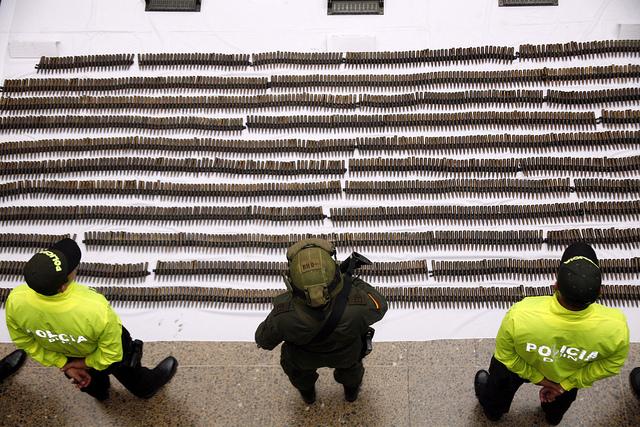Colombia: back from the brink
Posted By Anthony Bergin on July 15, 2014 @ 14:30
In an op-ed published yesterday [2], I highlighted how, with the right resources and strategies, a country could turn its security problems around.
I was referring to Colombia. I made a recent visit there with a small group of African political leaders and military commanders, arriving shortly after President Juan Manuel Santos’ re-election for another four years. And I found the security situation much improved.
Rewind to the late 1990s and Colombia was on the verge of being a failed state. In 2002, the government controlled just half of Colombia’s countryside. Ten years later, the figure’s over 90%. According to the World Bank’s ‘ease of doing business’ index, Colombia ranks third in Latin America [3]. This year, according to government projections, the economy could grow at 5% [4].
Part of that success is this: the Colombians have built an incredibly impressive military force, (we visited military bases and spent a day with Colombian Special Forces), and allocated resources to their armed forces and police (around 480,000 strong). The country’s defence budget has doubled over the last ten years.
The military is seen as the most respected institution in the country, even above the church, and the quality of the officer corps was evident. They’ve developed an efficient intelligence capability which has allowed the Colombians to conduct aerial attacks against the FARC in their jungle strongholds, resulting in high casualty rates for senior FARC leaders. The number of FARC combatants has dropped from around 20,000 in 2002 [5] to between 7,000 and 10,000 fighters [6].
Our group was given extensive briefings on the country’s two flagship security strategies: ‘Sword of Honour’ [7] and ‘Plan Green Heart’. The first is an integrated military and police effort which has launched simultaneous offensives across Colombia focusing on a dozen ‘hot zones’ where the guerrillas are active and have significant economic interests which overlap with those of the state, such as oil pipelines.
‘Plan Green Heart’ is the national police strategy aimed at combatting organised crime and crimes affecting citizen security. It’s focused on land reform, rural security, cybercrime, road security and urban security. It’s targeting drug trafficking, terrorism, criminal mining, kidnapping and extortion, smuggling, and mobile phone robbery.
I saw first-hand in La Macarena, a town about 280km south of Bogota and formerly a FARC stronghold, how the military has worked to improve service and infrastructure delivery at the community level across an extraordinarily rugged countryside. As one Colombian military officer explained to us: ‘the problem is rural, so the solution is rural’.
Colombia has benefited from strong and consistent political leadership over the last decade that’s focused on confronting drugs and guerrillas, and not just political spin. The CEO of the Colombian subsidiary of a major multinational company (that’s operated in Colombia for years) summed it up in a statement to our group: ‘The political leaders here work 24/7 for the country’. Defence Minister Juan Carlos Pinzon told us that ten years ago, ‘we’d lost our country, and now we’ve got it back’.
Colombia’s lessons are of relevance to other states facing armed challenges: my African travelling companions told me at the end of our visit they’d learnt a lot from Colombia in addressing some of their own internal security problems such as insecurity in eastern Congo, Boko Haram in Nigeria, insurgents in Mali, and Al-Shabab across east Africa.
Building military-military ties to facilitate information sharing and lessons learnt could be fruitful for both the ADF and Colombian military. That could begin with a visit by the new Vice Chief of the Defence Force, Vice Admiral Ray Griggs, to scope practical defence engagement, including for strategic dialogue, training and staff college exchanges and defence trade.
In particular, it would be useful to visit Buenaventura, a town of 400,000 and a major drug-trafficking node on Colombia’s Pacific coast, to see how Colombian’s navy is dealing with the problems of drugs and crime. Of interest too would be looking at the Colombia’s practical approach to force structure. Colombians are buying useful equipment such as turbo-prop aircraft for counter insurgency, transports and Blackhawks. Colombia has a long history of riverine warfare and they’ve got a large fleet of effective riverine combatants.
Australian Customs and the AFP would benefit from strengthening information exchange on the drug trade and trends in serious and organised crime.
A great highlight of my visit was cheering a Colombian victory in the World Cup, watching the match with the bravest of the brave—soldiers who’d lost limbs to FARC mines. With the remaining time left on the UNSC, we might consider offering Colombia help in dealing with the IED and de-mining problems the country faces. I’ll never forget those soldiers, or the staunchly patriotic Colombians I met.
Things are really changing for the better in the country. The tourism promotion says it all: ‘Colombia, the only risk is wanting to stay’.
Anthony Bergin is deputy director of ASPI. He travelled to Colombia courtesy of the Brenthurst Foundation. Image courtesy of Flickr user Colombian National Police [8].
Article printed from The Strategist: https://aspistrategist.ru
URL to article: /colombia-back-from-the-brink/
URLs in this post:
[1] Image: https://aspistrategist.ru/wp-content/uploads/2014/07/8485835322_3e7c25358b_z.jpg
[2] an op-ed published yesterday: https://www.aspistrategist.ru/publications/opinion-pieces/more-choice-in-colombia-than-bribes-and-bullets
[3] Colombia ranks third in Latin America: http://www.doingbusiness.org/rankings
[4] economy could grow at 5%: http://www.reuters.com/article/2014/04/15/colombia-economy-president-idUSL2N0N702R20140415
[5] around 20,000 in 2002: http://www.aljazeera.com/indepth/features/2011/05/2011523145921384863.html
[6] between 7,000 and 10,000 fighters: http://www.washingtonpost.com/world/the_americas/for-war-weary-rebels-colombia-invites-defections-with-comforts-and-kindness/2014/06/12/8f0643ca-35a5-419e-b5c1-ce95aa93c97e_story.html
[7] ‘Sword of Honour’: http://www.economist.com/blogs/americasview/2012/04/security-colombia
[8] Colombian National Police: https://www.flickr.com/photos/policiacolombia/8485835322
Click here to print.
